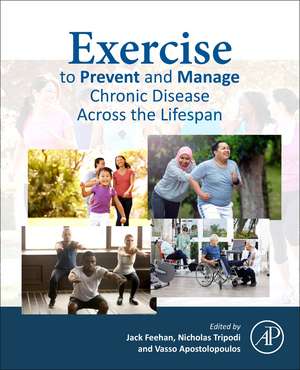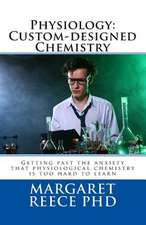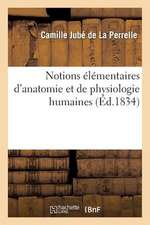Exercise to Prevent and Manage Chronic Disease Across the Lifespan
Autor Jack Feehan, Nicholas Tripodi, Vasso Apostolopoulosen Limba Engleză Paperback – 24 mai 2022
The book's synthesized research evidence allows practitioners to safely and effectively begin to capitalize on the benefits of exercise in their patients.
- Provides broad insights into the evidence-based underpinnings of the use of exercise in a range of common diseases
- Coverage includes the immune system, musculoskeletal disease, oncology, endocrinology, cardiology, respiratory diseases, and more
- Includes a glossary, bibliography and summary figures for quick reference of information
Preț: 715.62 lei
Preț vechi: 887.22 lei
-19% Nou
Puncte Express: 1073
Preț estimativ în valută:
136.98€ • 148.84$ • 115.14£
136.98€ • 148.84$ • 115.14£
Carte tipărită la comandă
Livrare economică 14-28 aprilie
Livrare express 14-20 martie pentru 195.12 lei
Preluare comenzi: 021 569.72.76
Specificații
ISBN-13: 9780323898430
ISBN-10: 0323898432
Pagini: 480
Ilustrații: 75 illustrations (25 in full color)
Dimensiuni: 216 x 276 x 30 mm
Greutate: 1.27 kg
Editura: ELSEVIER SCIENCE
ISBN-10: 0323898432
Pagini: 480
Ilustrații: 75 illustrations (25 in full color)
Dimensiuni: 216 x 276 x 30 mm
Greutate: 1.27 kg
Editura: ELSEVIER SCIENCE
Cuprins
Part I Introduction
1. Introduction
Part II General exercise
2. Exercise and immunity
3. Physical activity interventions for culturally and linguistically diverse populations: A critical review
4. Physical activity adherence: Worldwide trends, barriers and facilitators and tools to improve it
Part III Children and early teens (5-15)
5. The effects of physical exercise on the brain and neurocognitive functioning during childhood
6. Physical activity for young people with mental illness
7. Type 1 diabetes
8. Exercise across the lifespan: Exercise and obesity
9. Exercise effects in adults with asthma
10. Exercise training for people living with HIV
Part IV Middle age (35–65)
11. Type 2 diabetes, prediabetes, and gestational diabetes mellitus
12. Exercise in the management of multiple sclerosis
13. Exercise and menopause
14. Exercise for chronic pain
15. Exercise in the management of neuropathic pain
16. Tendinopathy
17. Exercise and depression
18. Yoga and mental health
19. Exercise for chronic heart failure
20. Exercise interventions in women with Polycystic Ovary Syndrome
Part V Older age
21. Exercise for the management of osteoarthritis
22. Exercise before and after orthopedic surgery
23. Exercise in stroke
24. Chronic respiratory diseases and physical exercise
25. Exercise in cancer
26. Exercise in the management of motor neuron disease
27. Tai Chi exercise to improve balance and prevent falls among older people with dementia
28. Osteosarcopenia and exercise
29. Exercise and older adults receiving home care services
30. Exercise in Parkinson’s disease
31. Exercise and Alzheimer’s disease
32. Exercise and the elderly: Gait and balance
33. Exercise and cognition in aging
1. Introduction
Part II General exercise
2. Exercise and immunity
3. Physical activity interventions for culturally and linguistically diverse populations: A critical review
4. Physical activity adherence: Worldwide trends, barriers and facilitators and tools to improve it
Part III Children and early teens (5-15)
5. The effects of physical exercise on the brain and neurocognitive functioning during childhood
6. Physical activity for young people with mental illness
7. Type 1 diabetes
8. Exercise across the lifespan: Exercise and obesity
9. Exercise effects in adults with asthma
10. Exercise training for people living with HIV
Part IV Middle age (35–65)
11. Type 2 diabetes, prediabetes, and gestational diabetes mellitus
12. Exercise in the management of multiple sclerosis
13. Exercise and menopause
14. Exercise for chronic pain
15. Exercise in the management of neuropathic pain
16. Tendinopathy
17. Exercise and depression
18. Yoga and mental health
19. Exercise for chronic heart failure
20. Exercise interventions in women with Polycystic Ovary Syndrome
Part V Older age
21. Exercise for the management of osteoarthritis
22. Exercise before and after orthopedic surgery
23. Exercise in stroke
24. Chronic respiratory diseases and physical exercise
25. Exercise in cancer
26. Exercise in the management of motor neuron disease
27. Tai Chi exercise to improve balance and prevent falls among older people with dementia
28. Osteosarcopenia and exercise
29. Exercise and older adults receiving home care services
30. Exercise in Parkinson’s disease
31. Exercise and Alzheimer’s disease
32. Exercise and the elderly: Gait and balance
33. Exercise and cognition in aging






















